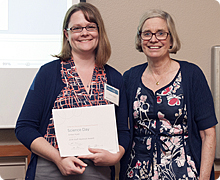Nurses Answer Clinical Questions by Leading Research
 Amber Hyatt, a charge nurse in Seattle Children’s Emergency Department (ED), proves that anyone with a little determination and curiosity can lead a research project.
Amber Hyatt, a charge nurse in Seattle Children’s Emergency Department (ED), proves that anyone with a little determination and curiosity can lead a research project.
In addition to her role in the ED, Hyatt is also a lead nurse in the Pediatric Transport Communication Center, which facilitates the transport and acceptance of patients to Seattle Children’s.
In 2013, she began thinking about ways the communication center could help the care team in the ED better anticipate the level of support patients being transported to the hospital will need. To do this, she wanted to explore whether the team could assign acuity levels to patients prior to their arrival at the hospital.
Hyatt applied for and received a Seattle Children’s nursing research grant in early 2014 and soon began researching the topic. The data collection process is now complete and she is in the final stages of the project. “I hadn’t done research before and it was a challenging process to go through, but now that I’m on the other end of it, I’m glad I did it,” said Hyatt.
A Unique Perspective
Hyatt’s project was one of the first research programs funded by Seattle Children’s Center for Pediatric Nursing Research, which began in 2013.
To date, the program has funded 26 research projects led by nurses. Seven of these projects have completed data collection and are in the writing phase for publication. The program also supports a few nurse-led research projects that do not require funding.
“We’re able to internally fund the projects, which is a fabulous way to support beginning researchers,” said Karen Thomas, nurse scientist in the Center for Pediatric Nursing Research. “It’s important to see that nursing is a scientific discipline unto itself.”
As a nurse-turned-researcher herself, Thomas helps nurses refine what they want to investigate, form a research question and apply for funding. She then connects them to resources and provides assistance throughout the process, including study design, completion of the IRB application process, data collection, analysis and writing for publication.
Thomas also serves on the planning committee for the annual Nursing Research Symposium each May and manages the program’s website and numerous research resources.
Recently, the program also funded a portion of Kristen Carlin’s salary. Carlin is a biostatistician from Seattle Children’s Research Institute who provides assistance to nurses to help with study design and analysis. Results from Hyatt’s project indicate that assigning a pre-arrival acuity level to patients is a good predictor of the level of care patients will need when they arrive to the hospital. The Pediatric Transport Communication Center is currently using Hyatt’s system. This research study is a great example of how nurse-led research can improve practice in a real clinical setting.
“From the ED standpoint, it gives the charge nurse the ability to plan for the patients coming in,” said Hyatt. “We hope that for the patients, they have a team more prepared to care for them quickly when they get here.”
As results from other research projects filter in, Thomas feels excited and proud to work with a group of nurses that bring their unique views to research. “Nurses bring a holistic perspective to the situation,” said Thomas. “The nurse sees the whole patient experience and often knows the patient best. Because they are frontline care providers, nurses raise the clinical questions that have an impact on patients and families.”